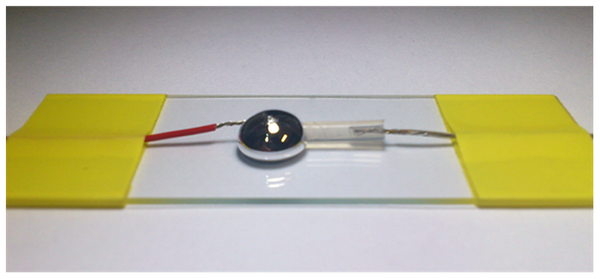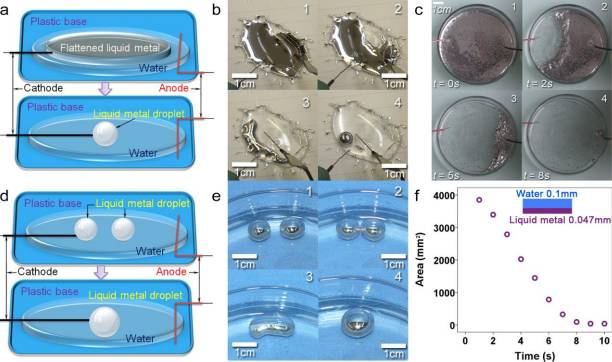
Soft Robots - The Battle for 3D Printed Liquid Metal Supremacy
Jun 26, 2014 Email"> PrintText Size

Liquid metals which self-assemble. Electrical charges used to make droplets of those metals fuse together into a variety of shapes and swirling configurations.
It sounds like science fiction of the sort which would have stretched the bounds of credulity a few short years ago, but now a renowned group of Chinese scientists say they've arrived at a method of producing liquid metals they can manipulate with electrical charges.
The research team from Tsinghua University and the Chinese Academy of Sciences says that though their methodology only allows them to realize simple shapes at this stage of the work, they can envision a day when much, much more will be possible.
The team, led by Lei Sheng, Jie Zhang, and Jing Liu of the Department of Biomedical Engineering, School of Medicine at Tsinghua in Beijing, says the breakthroughs will eventually result in complex objects being made from liquid metal like "soft" robots.
"A 'smart liquid metal machine' could be extended to three dimensions when a spatial electrode configuration is adopted," says Liu.
Using a 12-volt power supply and non-toxic alloys – which feature room-temperature melting points when submerged in water – the team demonstrated work during which interactions between the metals and the surface tension of the water create various three-dimensionalshapes.
Liquidmetal is the name given to a series of amorphous metal alloys developed by researchers at the California Institute of Technology. These alloys combine a number of desirable material features like high tensile strength, corrosion resistance and anti-wearingcharacteristics, and they can be heat-formed at very, very low temperatures.
When used in conjunction with ceramics, the zirconium-based alloys fuse at a temperature half that of conventional titanium alloys, and once it's cooled, Liquidmetal becomes roughly three times tougher than stainless steel.
Liu says the discovery is a first step towards making such devices as '3D modeling units' and electronic components. The liquid metal alloy material is malleable and considerably safer to handle in the laboratory than metals with similar properties such as the highly toxic mercury. Relatively inexpensive to manufacture, the team says the liquid metals will find uses in the sciences and in medical research.
The room temperature liquid metal is quickly emerging as an important functional material, so much so that Apple Inc has recently patented a variety of ideas for its use.
By applying an electrical field to the liquid metals, the researchers say they've managed to "self-assemble" a single sheet of liquid metal film and transform it into sphere, taking separate metal droplets and joining them to create "controlled self-rotation and planar locomotion" of the droplets.
By causing vortexes in the surrounding water, the team says they've reliably swirled and the rotated liquid metal sphere. (Source: 3D Printer World)

The physiological saline is sealed in a plastic tube.( Image by LIU Jing)

The electric-field-induced transformations of liquid metal objects in water. ( Image by LIU Jing)
Liquid metals which self-assemble. Electrical charges used to make droplets of those metals fuse together into a variety of shapes and swirling configurations.
It sounds like science fiction of the sort which would have stretched the bounds of credulity a few short years ago, but now a renowned group of Chinese scientists say they've arrived at a method of producing liquid metals they can manipulate with electrical charges.
The research team from Tsinghua University and the Chinese Academy of Sciences says that though their methodology only allows them to realize simple shapes at this stage of the work, they can envision a day when much, much more will be possible.
The team, led by Lei Sheng, Jie Zhang, and Jing Liu of the Department of Biomedical Engineering, School of Medicine at Tsinghua in Beijing, says the breakthroughs will eventually result in complex objects being made from liquid metal like "soft" robots.
"A 'smart liquid metal machine' could be extended to three dimensions when a spatial electrode configuration is adopted," says Liu.
Using a 12-volt power supply and non-toxic alloys – which feature room-temperature melting points when submerged in water – the team demonstrated work during which interactions between the metals and the surface tension of the water create various three-dimensionalshapes.
Liquidmetal is the name given to a series of amorphous metal alloys developed by researchers at the California Institute of Technology. These alloys combine a number of desirable material features like high tensile strength, corrosion resistance and anti-wearingcharacteristics, and they can be heat-formed at very, very low temperatures.
When used in conjunction with ceramics, the zirconium-based alloys fuse at a temperature half that of conventional titanium alloys, and once it's cooled, Liquidmetal becomes roughly three times tougher than stainless steel.
Liu says the discovery is a first step towards making such devices as '3D modeling units' and electronic components. The liquid metal alloy material is malleable and considerably safer to handle in the laboratory than metals with similar properties such as the highly toxic mercury. Relatively inexpensive to manufacture, the team says the liquid metals will find uses in the sciences and in medical research.
The room temperature liquid metal is quickly emerging as an important functional material, so much so that Apple Inc has recently patented a variety of ideas for its use.
By applying an electrical field to the liquid metals, the researchers say they've managed to "self-assemble" a single sheet of liquid metal film and transform it into sphere, taking separate metal droplets and joining them to create "controlled self-rotation and planar locomotion" of the droplets.
By causing vortexes in the surrounding water, the team says they've reliably swirled and the rotated liquid metal sphere. (Source: 3D Printer World)

The physiological saline is sealed in a plastic tube.( Image by LIU Jing)

The electric-field-induced transformations of liquid metal objects in water. ( Image by LIU Jing)
CAS Institutes
There are 124 Institutions directly under the CAS by the end of 2012, with 104 research institutes, five universities & supporting organizations, 12 management organizations that consist of the headquarters and branches, and three other units. Moreover, there are 25 legal entities affiliated and 22 CAS invested holding enterprisesThere are 124 I...>> more
Contact Us

Chinese Academy of Sciences
Add: 52 Sanlihe Rd., Xicheng District, Beijing, China
Postcode: 100864
Tel: 86-10-68597592 (day) 86-10-68597289 (night)
Fax: 86-10-68511095 (day) 86-10-68512458 (night)
E-mail: cas_en@cas.cn

